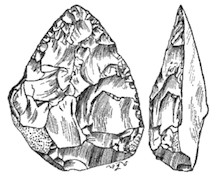The Stone Age saw the foundation of culture. Read about this fascinating epoch in prehistory.
Introduction

Stone tool from the early Paleolithic
The Stone Age was the period when prehistoric humans (and our forerunners) made and used stone tools. This started roughly 3.3 million years ago! The specifics of this era aren’t easy to determine, since this was before writing was developed, yet the importance of the Stone Age is very clear: this is the first time people had semi-permanent tools. This was the foundation for our society! Everything we have and use started then — with ancient inventors who thought it’d be nifty to carve stone into hammers, or blades, or whatever they could imagine [or, whatever made life easier].
The tools from this period weren’t all of stone; other hard materials, such as bone and antler, were also used.
Paleolithic, Mesolithic, and Neolithic Periods
There are relatively few artifacts remaining to shed light on the Stone Age; we are lucky to have found some. This era was well before written history (this is known as prehistory) so our knowledge of it comes from archeological excavations and geological science.
The Stone Age is divided into the Paleolithic (early), Mesolithic (middle), and Neolithic (late) Periods. These periods are distinguished by the complexity of the tools and how specifically designed they were to do a particular job, and also by how many resources the humans of the period were able to gather: were they only just scraping by (Paleolithic), could they find more by traveling around as hunter-gatherers while using tools (Mesolithic), or were they able to collect and store food by establishing a permanent home with a farm (Neolitjhic)?
The Ice Age (Pleistocene Epoch)
Throughout this era of human and societal evolution, the world itself was transforming. The Stone Age, characterized by humans’ development of tools, intersects with a different sort of geological period — the Ice Age (or Pleistocene Epoch), which lasted for more than two million years! This epoch saw bitterly cold periods in which glaciers advanced, and also warming periods when the ice sheets retreated, sculpting the modern landscape we know. The geologic changes were intertwined with the Stone Age, as the shifting climate allowed humans to evolve.
Lifestyle Changes over Time
The humans in the Paleolithic Period were nomadic hunter-gatherers. As the years went by, the stone tools became more specialized, to perform exact tasks. The Mesolithic saw the rise of temporary settlements, still within a huntering-gathering life, and then, in the Neolithic, people started farming and domesticating animals, giving them a more stable food supply as they settled down in what became small villages.
The tools that defined the Stone Age were incredibly varied and weren’t all made of stone (though the only ones that survived were made of very hard materials, such as the bone and antler mentioned earlier). The tools were designed to help procure food, to aid in defense, to build structures, and even to make other tools. Tools ranged from anvils, hammers, and blades to bows and arrows, chisels, and axes. Another pivotal “tool” early on was the invention of fire!
As time passed, these tools became much more complicated. They also began resembling things we use today: from fishing rods to needles and thread for sewing. The types of tools used changed depending on the part of the world. Societies near water would build boats, canoes, and fishing equipment, while those in cold areas perhaps had more axes to help collect firewood from trees.
Art and Culture
Though stone tools were of great importance to the Stone Age, it’s important not to lose sight of everything else that was happening. Modern man was evolving—quite literally! Early on, there were many different branches of what can be defined as humans. Over time, ancestors of our own species (Homo sapiens) rose to prominence.
One key part of this age was the art that was created. When we think of cavemen, we also think of cave art: murals of the Stone Age world that were painted onto stone walls with fingers or primitive tools. Animals, plants, and their fellow humans were typical subjects of these works of art. As the times progressed the art became more extensive, though the subjects remained very similar. Small statues (in bone, stone, ivory, etc.) started to be made, early humans danced to their own music, pottery was spun with geometric patterns, and grand structures (such as Stonehenge) were made for ceremonious reasons. These give archeologists an amazing peek at early man’s perspective on the world.
Conclusion
The Stone Age saw the rise of much of what makes us human. People made tools, and they also began to dance, create art, and compose music! This was accompanied by the development of governing laws and religious ceremonies. All of the complexities of human thought and society were coming to fruition. By the end of the Stone Age, people were no longer living in caves. They had come out into the light and were creating civilizations around the world.
